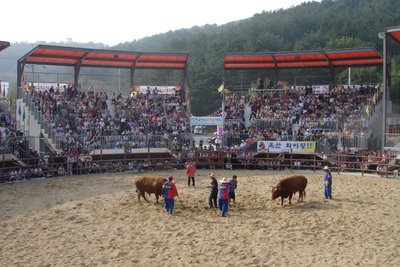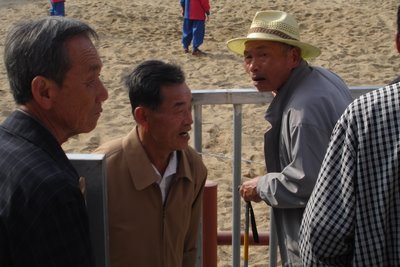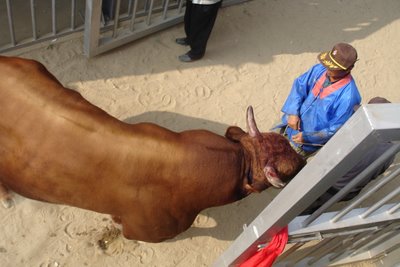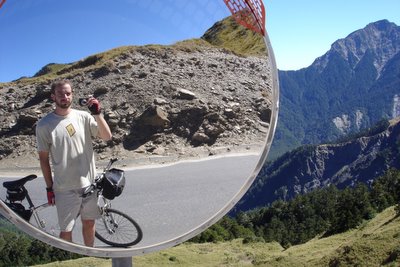Friday, December 29, 2006
Wednesday, December 27, 2006
Sunday, December 03, 2006
consider yourself informed
There seems to be a system in Korea whereby the government plans and contracts the construction of every apartment building to Hyundai, Samsung, and the other conglomerates. Individual apartments are then sold off by the government. Contrast this with our system, in which a developer proposes a building, sells the units at a price set for profit, and begins construction.
Korea's system allows for a housing allocation system, which was recently adjusted to benefit families with three or more children. This is part of the governments campaign to bring up the birthrate. If you didn't know, Korea is a country full of dinks - that is "dual income, no kids".
I'm serious, it's part of the Korean vernacular.
What's that you say? Corea? Interesting that you should ask about that.
Many Koreans actually write the word "Corea" in reference to their country. This is also related to the Japanese occupation. The argument goes that the Japanese began to romanize the name using a K, while previously a C was used. Something about making sure that Corea did not precede Japan at any international meetings (it's alphabetical see?). This has become a national issue, and strong rallying call of many a Corean nationalist.
I should note that my use of the word "Korea" is in no way an endorsement of Japanese colonial ideas or actions. In fact, I don't think that anyone's usage of the term is - apart from the Koreans who have made it an issue. That's just my value judgement though.
Those interested in the history of the Korea/Corea distinction might read about it in this interesting article, which includes historical evidence (read: cool old photos) including postage stamps, passports, and stationary suggesting the dubious nature of the claim that it was the Japanese that changed the romanization. You might also read these interesting articles about the Sea of Japan naming dispute and a letter writing campaign that some Korean students launched to bring international attention to the claims. Turns out that National Geographic has listed "East Sea" as an alternative name as a result of their efforts.
Sunday, November 19, 2006
TaGong Grasslands
I haven't been taking many pictures recently, but I'm going to post some pictures from earlier in the year. This series is from the TaGong Grasslands in western SiChuan. It's about 100 km from the Tibet's political border, but well inside Tibet's cultural border.
 Downtown TaGong.
Downtown TaGong.
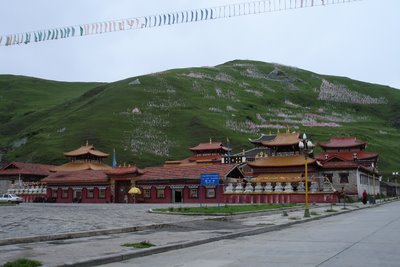 The main temple.
The main temple.
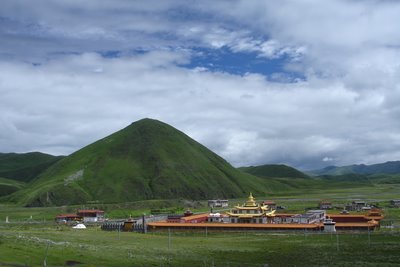 An outlying temple.
An outlying temple.
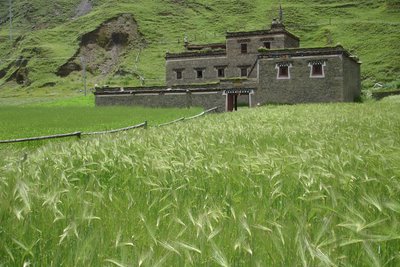 A traditional house unique to the TaGong area.
A traditional house unique to the TaGong area.
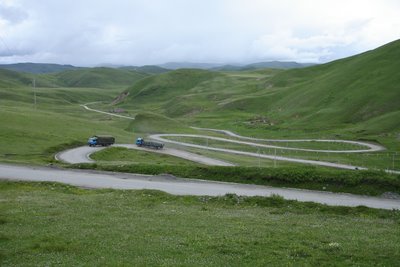
 Downtown TaGong.
Downtown TaGong. The main temple.
The main temple.  An outlying temple.
An outlying temple.  A traditional house unique to the TaGong area.
A traditional house unique to the TaGong area.
Saturday, November 18, 2006
Brave New World
This should give you something to think about today.
Do you think it's a coincidence that he is a political lobbyist?
Do you think it's a coincidence that he is a political lobbyist?
Monday, October 30, 2006
Songnisan National Park Riding
 Here are a few pictures of a five day trip I just finished. I took a bus to the center of South Korea last Thursday to meet Gordon, already on the road, and spent the days hiking and riding back to Jinju.
Here are a few pictures of a five day trip I just finished. I took a bus to the center of South Korea last Thursday to meet Gordon, already on the road, and spent the days hiking and riding back to Jinju.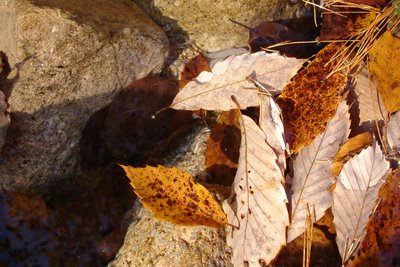 It's fall.
It's fall.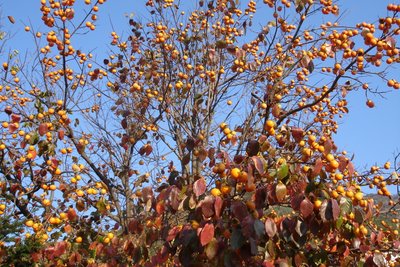 Persimmon trees are everywhere, and they are ready to harvest.
Persimmon trees are everywhere, and they are ready to harvest.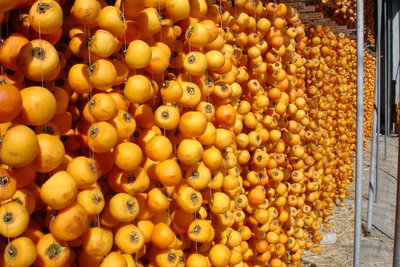 After they get them off the trees, they tie them up to dry. We were gifted fresh persimmons and apples by many a farmer on the trip.
After they get them off the trees, they tie them up to dry. We were gifted fresh persimmons and apples by many a farmer on the trip.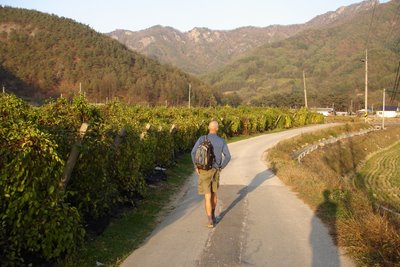 Walking back to the park gate late in the day after a hike.
Walking back to the park gate late in the day after a hike.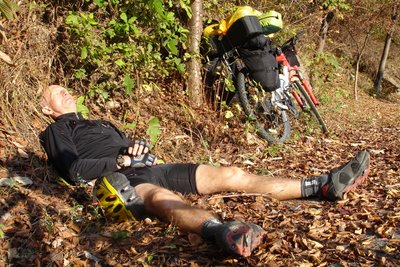 Gord naping in the last light of day. The weather is perfect for hiking and biking, but it gets cold at night. Fortunately I have sweet sleeping bag from China that keeps me warm in my tent. Gord was not so lucky with his gear.
Gord naping in the last light of day. The weather is perfect for hiking and biking, but it gets cold at night. Fortunately I have sweet sleeping bag from China that keeps me warm in my tent. Gord was not so lucky with his gear.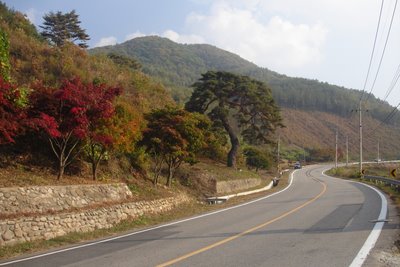 Fall colours riding back to Jinju.
Fall colours riding back to Jinju.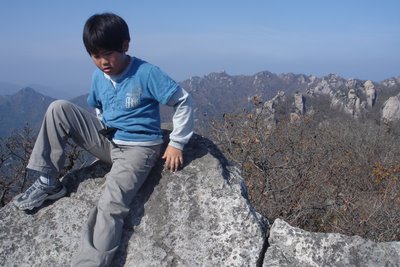 On top of Songnisan. Obviously it was a difficult hike if hikers of this magnitude were making it too the top.
On top of Songnisan. Obviously it was a difficult hike if hikers of this magnitude were making it too the top.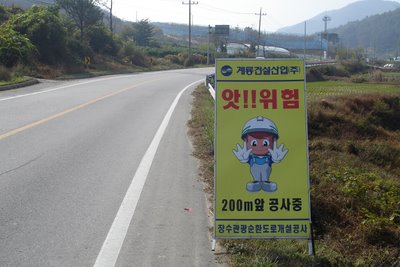 A construction sign apparently advocating child labour? Or, at least showing the influence of anime.
A construction sign apparently advocating child labour? Or, at least showing the influence of anime.
Sunday, October 15, 2006
bike shop guy
Those who cycle and often find themselves living in new locales know the importance of finding a bike shop guy. You know, a guy to keep you in parts and - more importantly - to take you out into the country side and show you where all the good riding is.
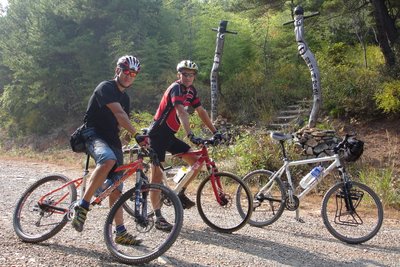 Finally found one here in Jinju. Myeong-gook owns and runs his one-man shop downtown.
Finally found one here in Jinju. Myeong-gook owns and runs his one-man shop downtown.

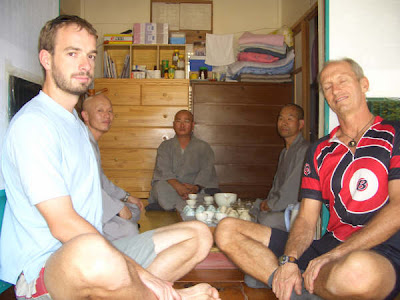 We went out on the back roads for the day, and late in the afternoon ended up at a temple where we were invited in for tea by some kindly monks. It was a good day.
We went out on the back roads for the day, and late in the afternoon ended up at a temple where we were invited in for tea by some kindly monks. It was a good day.
 Finally found one here in Jinju. Myeong-gook owns and runs his one-man shop downtown.
Finally found one here in Jinju. Myeong-gook owns and runs his one-man shop downtown.
 We went out on the back roads for the day, and late in the afternoon ended up at a temple where we were invited in for tea by some kindly monks. It was a good day.
We went out on the back roads for the day, and late in the afternoon ended up at a temple where we were invited in for tea by some kindly monks. It was a good day.
Saturday, October 14, 2006
Tuesday, October 10, 2006
Finally back on the road.
Autumn festival just passed in Korea (Chuseok), and we had a four day weekend to celebrate.
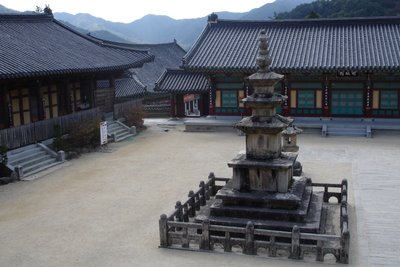 Gord and I went on a cycling/hiking tour of the area north of JinJu. We visited two National Parks, summited two peaks and cycled a couple hundred kilometers through the country side. We stayed in a Zen Temple, camped on a riverside, and spend a night at a JimJil Bang. It was a trip with a lot of firsts for me in Korea. I'm looking forward to seeing more of Korea in the coming weeks.
Gord and I went on a cycling/hiking tour of the area north of JinJu. We visited two National Parks, summited two peaks and cycled a couple hundred kilometers through the country side. We stayed in a Zen Temple, camped on a riverside, and spend a night at a JimJil Bang. It was a trip with a lot of firsts for me in Korea. I'm looking forward to seeing more of Korea in the coming weeks.
 We stayed at Haeinsa Temple. It's another UNESCO world heritage kind of place in Gaya San National Park. They keep a hundred thousand or so of these 500 year old wooden blocks that some monks made to print Buddhist Sutras. We attended the evening chanting, and woke up to the gong at 3 am for more chanting and meditating. It was a really great experience.
We stayed at Haeinsa Temple. It's another UNESCO world heritage kind of place in Gaya San National Park. They keep a hundred thousand or so of these 500 year old wooden blocks that some monks made to print Buddhist Sutras. We attended the evening chanting, and woke up to the gong at 3 am for more chanting and meditating. It was a really great experience.
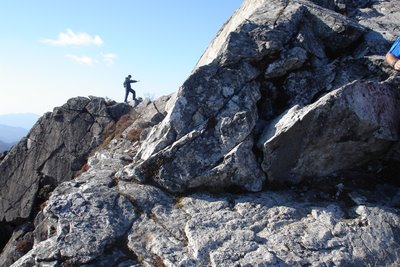 We summited Gayasan on the first day after cycling to the park. A nice peak with a good view of the valleys below.
We summited Gayasan on the first day after cycling to the park. A nice peak with a good view of the valleys below.
 Too cool for school.
Too cool for school.
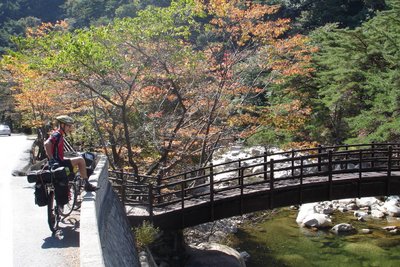 On the second day we left the park to cycle 70 k to the next park. Note the Autumn colours! I realized I haven't experienced autumn in three years (Taiwan being tropical/sub-tropical).
On the second day we left the park to cycle 70 k to the next park. Note the Autumn colours! I realized I haven't experienced autumn in three years (Taiwan being tropical/sub-tropical).
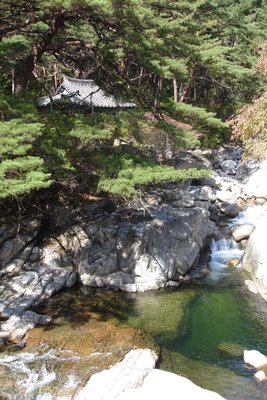 This pagoda was just across the bridge. I was just stepping off the bridge when I saw a small brown snake at my feet. I stepped quickly to the right and found myself standing over a much bigger snake with bright green, blue, and red markings. I jumped up in the air at the same time that it lunged at me and managed to get a few steps away. To be honest, it was not the lightning fast lunge that you might be imagining. It was fairly early morning, and I think the snakes were warming themselves in the sun. They weren't in top form anyway.
This pagoda was just across the bridge. I was just stepping off the bridge when I saw a small brown snake at my feet. I stepped quickly to the right and found myself standing over a much bigger snake with bright green, blue, and red markings. I jumped up in the air at the same time that it lunged at me and managed to get a few steps away. To be honest, it was not the lightning fast lunge that you might be imagining. It was fairly early morning, and I think the snakes were warming themselves in the sun. They weren't in top form anyway.
 Yellowing rice fields along the way.
Yellowing rice fields along the way.
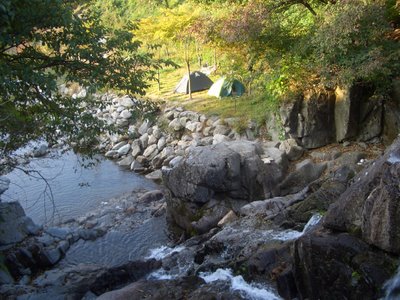 We found a great campsite just outside of the second park set against a natural waterfall.
We found a great campsite just outside of the second park set against a natural waterfall.
 Gord raided the apple orchirds in the morning for breakfast. That apple was almost as big as my head.
Gord raided the apple orchirds in the morning for breakfast. That apple was almost as big as my head.
 The third day we hiked 9 k on a deserted trail to summit a mountain that turned out to have a gondola on the other side! This is what that looks like. Gord is indicating that this is the seventh National Park he has visited. He's trying to visit all 20 National Parks in the country and climb their respective peaks.
The third day we hiked 9 k on a deserted trail to summit a mountain that turned out to have a gondola on the other side! This is what that looks like. Gord is indicating that this is the seventh National Park he has visited. He's trying to visit all 20 National Parks in the country and climb their respective peaks.
After the hike, we rode into the nearest town and checked into a JimJil Bang. They must be a phenomenon unique to Korea. It's often called a Sauna, but it includes hot baths of differing temperatures as well, including a refrigerated pool. The unique part is that after bathing for a couple hours, you can retire to common rooms where everyone passes out on thin mats for the night. These places are full of families passing through town, so it's an interesting atmosphere, made more interesting by the fact that everyone is wearing matching cotton shorts and t-shirts. There was a restaurant, big screen televisions, and coin operated computers located among the common rooms. Good times.
 And finally, a portrait of my bike. Two of these carvings (male and female) were traditionally found outside of every village to ward of evil spirits. But, these two were just looking good on the side of the road in the middle of nowhere.
And finally, a portrait of my bike. Two of these carvings (male and female) were traditionally found outside of every village to ward of evil spirits. But, these two were just looking good on the side of the road in the middle of nowhere.
And that was that.
 Gord and I went on a cycling/hiking tour of the area north of JinJu. We visited two National Parks, summited two peaks and cycled a couple hundred kilometers through the country side. We stayed in a Zen Temple, camped on a riverside, and spend a night at a JimJil Bang. It was a trip with a lot of firsts for me in Korea. I'm looking forward to seeing more of Korea in the coming weeks.
Gord and I went on a cycling/hiking tour of the area north of JinJu. We visited two National Parks, summited two peaks and cycled a couple hundred kilometers through the country side. We stayed in a Zen Temple, camped on a riverside, and spend a night at a JimJil Bang. It was a trip with a lot of firsts for me in Korea. I'm looking forward to seeing more of Korea in the coming weeks. We stayed at Haeinsa Temple. It's another UNESCO world heritage kind of place in Gaya San National Park. They keep a hundred thousand or so of these 500 year old wooden blocks that some monks made to print Buddhist Sutras. We attended the evening chanting, and woke up to the gong at 3 am for more chanting and meditating. It was a really great experience.
We stayed at Haeinsa Temple. It's another UNESCO world heritage kind of place in Gaya San National Park. They keep a hundred thousand or so of these 500 year old wooden blocks that some monks made to print Buddhist Sutras. We attended the evening chanting, and woke up to the gong at 3 am for more chanting and meditating. It was a really great experience. We summited Gayasan on the first day after cycling to the park. A nice peak with a good view of the valleys below.
We summited Gayasan on the first day after cycling to the park. A nice peak with a good view of the valleys below. Too cool for school.
Too cool for school. On the second day we left the park to cycle 70 k to the next park. Note the Autumn colours! I realized I haven't experienced autumn in three years (Taiwan being tropical/sub-tropical).
On the second day we left the park to cycle 70 k to the next park. Note the Autumn colours! I realized I haven't experienced autumn in three years (Taiwan being tropical/sub-tropical). This pagoda was just across the bridge. I was just stepping off the bridge when I saw a small brown snake at my feet. I stepped quickly to the right and found myself standing over a much bigger snake with bright green, blue, and red markings. I jumped up in the air at the same time that it lunged at me and managed to get a few steps away. To be honest, it was not the lightning fast lunge that you might be imagining. It was fairly early morning, and I think the snakes were warming themselves in the sun. They weren't in top form anyway.
This pagoda was just across the bridge. I was just stepping off the bridge when I saw a small brown snake at my feet. I stepped quickly to the right and found myself standing over a much bigger snake with bright green, blue, and red markings. I jumped up in the air at the same time that it lunged at me and managed to get a few steps away. To be honest, it was not the lightning fast lunge that you might be imagining. It was fairly early morning, and I think the snakes were warming themselves in the sun. They weren't in top form anyway. Yellowing rice fields along the way.
Yellowing rice fields along the way. We found a great campsite just outside of the second park set against a natural waterfall.
We found a great campsite just outside of the second park set against a natural waterfall. Gord raided the apple orchirds in the morning for breakfast. That apple was almost as big as my head.
Gord raided the apple orchirds in the morning for breakfast. That apple was almost as big as my head. The third day we hiked 9 k on a deserted trail to summit a mountain that turned out to have a gondola on the other side! This is what that looks like. Gord is indicating that this is the seventh National Park he has visited. He's trying to visit all 20 National Parks in the country and climb their respective peaks.
The third day we hiked 9 k on a deserted trail to summit a mountain that turned out to have a gondola on the other side! This is what that looks like. Gord is indicating that this is the seventh National Park he has visited. He's trying to visit all 20 National Parks in the country and climb their respective peaks.After the hike, we rode into the nearest town and checked into a JimJil Bang. They must be a phenomenon unique to Korea. It's often called a Sauna, but it includes hot baths of differing temperatures as well, including a refrigerated pool. The unique part is that after bathing for a couple hours, you can retire to common rooms where everyone passes out on thin mats for the night. These places are full of families passing through town, so it's an interesting atmosphere, made more interesting by the fact that everyone is wearing matching cotton shorts and t-shirts. There was a restaurant, big screen televisions, and coin operated computers located among the common rooms. Good times.
 And finally, a portrait of my bike. Two of these carvings (male and female) were traditionally found outside of every village to ward of evil spirits. But, these two were just looking good on the side of the road in the middle of nowhere.
And finally, a portrait of my bike. Two of these carvings (male and female) were traditionally found outside of every village to ward of evil spirits. But, these two were just looking good on the side of the road in the middle of nowhere.And that was that.
Subscribe to:
Posts (Atom)
